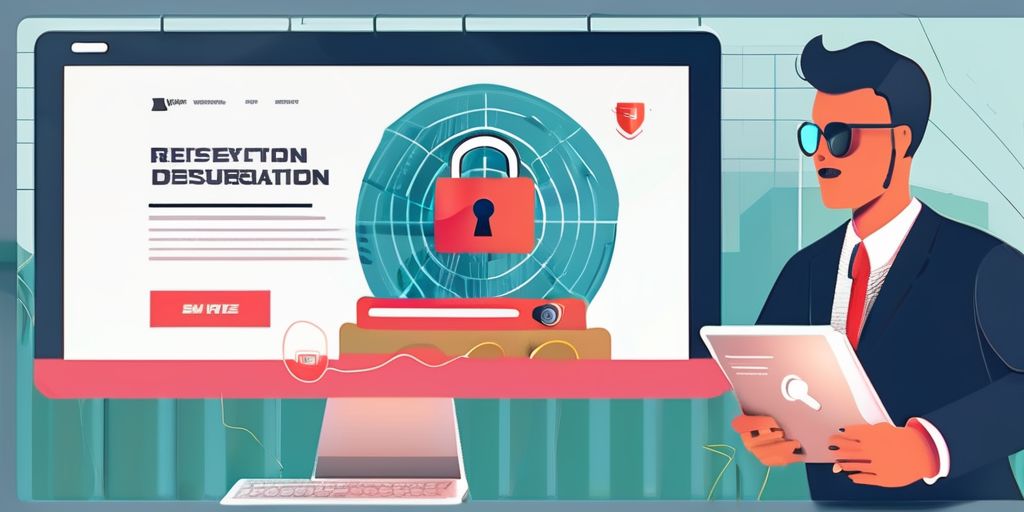Malware can pose a significant threat to websites, causing various issues such as data breaches, unauthorized access, and damage to reputation. In this article, we will explore the process of removing malware from your website, from understanding what malware is to securing your website to prevent future attacks. By following the steps outlined in this article, you can effectively remove malware and protect your website from potential threats.
Key Takeaways
- Understanding what malware is and how it affects websites is crucial in effectively removing it.
- Detecting malware can be done through signs of infection, using security tools, and scanning website files.
- Removing malware involves backing up your website, identifying and removing malicious code, and updating vulnerable software.
- Securing your website includes implementing strong passwords, regularly updating software, and using a web application firewall.
- Taking proactive measures such as regular scanning, backups, and security updates can help prevent malware infections in the future.
Understanding Malware
What is Malware?
Malware is any malicious software built to gain unauthorized access to your device and, in most cases, steal information for financial gain. Malware comes in many forms, including viruses, adware, worms, trojans, spyware, ransomware, keyloggers, and rootkits. If malware infects your computer or smartphone, it may steal your personal or financial information, damage your device, or cause other serious problems. Learn how malware works.
Types of Malware
Malware comes in many forms, including viruses, adware, worms, trojans, spyware, ransomware, keyloggers, and rootkits. If malware infects your computer or smartphone, it may steal your personal or financial information, damage your device, or cause other serious problems. Learn how malware works.
How Malware Affects Websites
The presence of malware on your website can have far-ranging consequences for your business operations. It can lead to a ‘Deceptive site ahead’ warning by search engines, causing your site to be flagged as unsafe for visitors. Additionally, malware can cause abnormal spikes in CPU and memory usage, resulting in performance issues such as slow website loading times and server errors. Furthermore, malware can negatively impact user experience, leading to login issues, redirects to other sites, and triggering spam warnings for website emails. It is crucial to regularly scan and remove malware from your website to mitigate these risks.
Detecting Malware
Signs of Malware Infection
If your device frequently crashes, it could equally be a sign of an overworked and faulty setup or a symptom of a freshly installed virus. Try to remember when your device started experiencing these crashes, as it can help identify the cause. Additionally, look out for unusual behavior such as sudden slowdowns, repeated error messages, or an influx of pop-ups and inappropriate ads. These signs may indicate that your device has been infected with malware. It’s important to address these issues promptly to prevent further damage to your device and website.
If you suspect malware infection, consider checking the CPU and memory usage of your website. Abnormally high usage can be a red flag for malware, as it can cause performance issues and lead to server resource exhaustion. Keep an eye out for a significant decrease in website speed or inaccessible errors, as these can also be indicators of malware. Remember to regularly monitor your website’s performance and take appropriate measures to secure it against potential threats.
In addition to these signs, be cautious of any unexpected changes to your website, such as new toolbars, icons, or default search engines. These alterations can be from hackers seeking to exploit your website’s security vulnerabilities. If you notice any suspicious activity or a sudden decrease in performance, it is essential to investigate the root cause promptly and take necessary actions to remove the malware and protect your website.
Using Security Tools
When it comes to detecting malware on your website, using security tools is an essential step. One of the easiest and quickest ways to detect and remove malware from WordPress sites is to use a plugin. Fortunately, there are a handful of options to choose from. These plugins can scan your website files, identify any malicious code, and provide you with a detailed report of the infected files. Additionally, you can also use online malware scanners to quickly scan your website and confirm if it has been hacked. However, it’s important to note that online scanners can only check the publicly visible files, so they may not catch hidden malware. We recommend using these scanners as a first layer of diagnosis, in combination with other security tools.
It’s crucial to regularly check your website for any signs of malware infection. Implementing security tools can help you stay proactive in protecting your website and ensuring its integrity.
Scanning Website Files
Scanning website files is an essential step in detecting and removing malware from your website. There are several methods you can use to scan your website files for malware. One option is to use online malware scanners, which can quickly scan your publicly visible files. However, it’s important to note that online scanners may not catch malware hidden in other files. We recommend using online scanners as a first layer of diagnosis, but not as the sole method. Another option is to use security plugins or hire an expert to perform a thorough scan and cleanup of your website. Additionally, Google offers tools like Transparency Report and Diagnostic Pages to help determine if your website is infected. These tools can provide valuable information about malware on your website. Remember to regularly scan your website files to ensure the security and integrity of your website.
Removing Malware
Backup Your Website
Taking regular backups of your website is crucial for ensuring the safety and security of your data. In the unfortunate event of a malware attack or website crash, having a recent backup can save you from losing valuable information. There are several methods you can use to backup your website:
- Use a Plugin: WordPress offers a variety of backup plugins, such as UpdraftPlus, that simplify the backup process. These plugins allow you to take a full backup of your site, including files and databases. Simply install and activate the plugin, and follow the instructions to backup your website.
- Backup Via SSH: If you prefer a more manual approach, you can backup your website using SSH. Access your website via SSH and run the command ‘zip -r backup-pre-cleanup.zip’. This will create a zip file of your website that you can download and store on your computer.
- Backup Via SFTP: Another option is to use SFTP to manually backup your website. You can use an SFTP client like Filezilla to connect to your website and download the necessary files.
Remember, it’s important to regularly schedule backups to ensure you have the most up-to-date version of your website in case of any emergencies.
Identify and Remove Malicious Code
After detecting malware on your website, the next step is to identify and remove the malicious code. This is a crucial step in ensuring the security and integrity of your website. Here are some steps to help you in this process:
- Review your website files: Carefully examine your website files to search for any suspicious code. Keep in mind that not all changes in the files are necessarily bad, especially if you have customized any of your extensions. Look for any code that seems out of place or unfamiliar.
- Use a security plugin: Consider using a reliable security plugin to assist you in scanning and identifying malicious code. These plugins often have advanced scanning capabilities and can help you pinpoint any potential threats.
- Manual inspection: If you prefer a more hands-on approach, you can manually inspect your website files for malicious code. This involves searching for common backdoor keywords or terms such as eval, preg_replace, str_replace, base64_decode, and gzinflate. If you find any of these keywords, it is important to carefully evaluate whether they are part of the malware or legitimate website code.
- Remove the malicious code: Once you have identified the malicious code, it is crucial to remove it promptly. Depending on the complexity of the code and your technical expertise, you can either manually delete the code or use a WordPress malware removal plugin for assistance.
- Reupload cleaned files: After removing the malicious code, it is important to reupload the cleaned files to your website. This process is similar to restoring a backup manually. You can use cPanel or SFTP to delete the infected files and replace them with the clean versions.
Remember, removing the malicious code is just one step in the overall process of securing your website. It is important to take additional measures to prevent future malware infections and protect your website from potential threats.
Update and Patch Vulnerable Software
Regularly updating and patching vulnerable software is crucial for maintaining the security of your website. Software applications, such as Adobe Acrobat, Mozilla Firefox, and WordPress, often have vulnerabilities that can be exploited by hackers. To protect your website from these vulnerabilities, it is important to install updates as soon as they are released. This can be done through the Vulnerability and Patch Management module in OneView, which allows you to easily update software applications. By keeping your software up to date, you can minimize the risk of malware infections and unauthorized access to your website.
In addition to updating software, it is also recommended to regularly scan your website for malware. Conducting regular scans helps you identify and remove malware before it causes any damage. By scanning your website on a regular basis, you can stay proactive in detecting and addressing any security issues. Implementing a regular scanning routine is an essential part of maintaining the security of your website.
To summarize, here are the key steps to update and patch vulnerable software:
- Install updates for software applications such as Adobe Acrobat, Mozilla Firefox, and WordPress.
- Use the Vulnerability and Patch Management module in OneView for easy software updates.
- Regularly scan your website for malware to identify and remove any threats.
Remember, keeping your software up to date and conducting regular scans are important measures to protect your website from malware and security breaches.
Securing Your Website
Implement Strong Passwords
Implementing strong passwords is crucial for protecting your website from unauthorized access. Weak passwords are one of the main reasons why websites get hacked, as they can be easily cracked by attackers. To ensure the security of your website, follow these best practices:
- Use a combination of uppercase and lowercase letters, numbers, and special characters in your passwords.
- Avoid using common words, personal information, or sequential patterns.
- Regularly update your passwords and avoid reusing them for multiple accounts.
By implementing strong passwords, you can significantly reduce the risk of unauthorized access to your website and protect your valuable data.
Regularly Update Software
Updating your website software regularly is crucial for maintaining its security. Developers often discover vulnerabilities in themes, plugins, and even the website platform itself. To address these vulnerabilities, they release patches and updates. By regularly updating your website, you ensure that these security fixes are applied, making it more difficult for hackers to exploit any weaknesses. Implementing automatic updates can streamline this process and ensure that your website is always running on the latest, most secure version of the software.
Use a Web Application Firewall
A web application firewall (WAF) is a cybersecurity tool that sits between a web application and the internet, monitoring, filtering, and blocking potentially malicious traffic based on predefined security rules. It acts as a gatekeeper, keeping out malicious traffic and protecting your website from various types of attacks. Implementing a WAF is an effective way to enhance the security of your website.
Here are some key benefits of using a web application firewall:
- Enhanced Security: A WAF adds an extra layer of security to your website, preventing unauthorized access and protecting against common web application vulnerabilities.
- Real-time Monitoring: A WAF continuously monitors incoming traffic and can quickly detect and block suspicious activity, reducing the risk of a successful attack.
- Protection Against DDoS Attacks: A WAF can help mitigate Distributed Denial of Service (DDoS) attacks by identifying and blocking malicious traffic before it reaches your website.
By implementing a web application firewall, you can significantly reduce the risk of your website being compromised by malware and other cyber threats. It is an essential component of a comprehensive website security strategy.
Securing your website is crucial to protect your business and your customers’ data. With the increasing number of cyber threats, it is important to implement robust security measures. At Home – Business Website Security, we specialize in providing comprehensive website security solutions. Our team of experts will help you identify vulnerabilities, implement strong security protocols, and monitor your website for any suspicious activities. Don’t wait until it’s too late, take action now to secure your website and safeguard your business. Visit our website today to learn more about our services and how we can help you protect your online presence.
Conclusion
In conclusion, removing malware from your website is a crucial step in ensuring its security and protecting your brand reputation. By following the steps outlined in this article, such as scanning your website with a reliable security plugin, cleaning up any detected malware, and taking preventive measures like installing a firewall and changing passwords, you can effectively remove malware and safeguard your website from future attacks. Remember, acting swiftly is key, as malware can cause significant damage if left unchecked. Stay vigilant and prioritize the security of your website to maintain a safe online presence.







